Door Controller
Bhadre Access Control Systems - An Introduction
Bhadre access controller is a smart controller that can be used for controlling and managing access to any restricted or public areas. The restricted areas can be a house, office, building, garage doors and gates, or anything similar. It can also be a private parking lot of an apartment complex or office. Public areas are public parking lots (paid or free), public transportation systems, cinema halls, GYMs, caravan parks and so on. Bhadre access controller can be integrated with any of the existing controller. With this integration, one can use his universal ID card, smartphone, QRcode or fingerprint to open/close a gate or a door. One can also use Google Home, Google Nest, Google Smart Home or Amazon Alexa to operate the door/gate. The doors/gates can be operated from anywhere remote. One can also know the current status of the door/gate (whether open or closed) from remote. Notifications can be configured to send if the door/gate remains open for a long time. If it is a garage door or gate, one can configure AutoClose such that the garage door/gate gets automatically closed after a pre-configured delay. Multiple users can be authorized to open/close the door/gate. The owner of the controller can revoke this authorization any time. It is also possible to configure the door/gate such that the authorization gets automatically revoked after a date/time. In addition, one can configure open and close times such that only between these times the authororized persons can access the door/gate. It is also possible to set authorizations such that some people are allowed to use only during some specific time period on pre-configured days of the week. Two factor authentication such as pin or fingerprint can also be optionally configured in places where high securtity is required. Entry to a public place can also be controlled based on age, gender or citizenship. When used for paid parking lots, public transport, or cinema halls, entry fees are charged automatically and debited to their credit card using Stripe system. Booking a place or holding a place in public places such as cinema halls and parking lots are also possible. This documentation describes how the smart controller can be installed and how the smart device can be configured to meet all the needs.
Bhadre provides two different access controllers - one for using with Garage Doors and gates and 2) for using with doors of buildings, offices and houses.
This document is for the Door Controller
1 Door Controller
For controlling a door or a solenoid, the controller used is this one with the details shown below. It is a small unit with dimensions 53mmx53mmx25mm. It has a 12V power socket and it takes 12V power input. Solenoid or coil of an electric strike on the door is cabled to an internal connector within the box of this controller.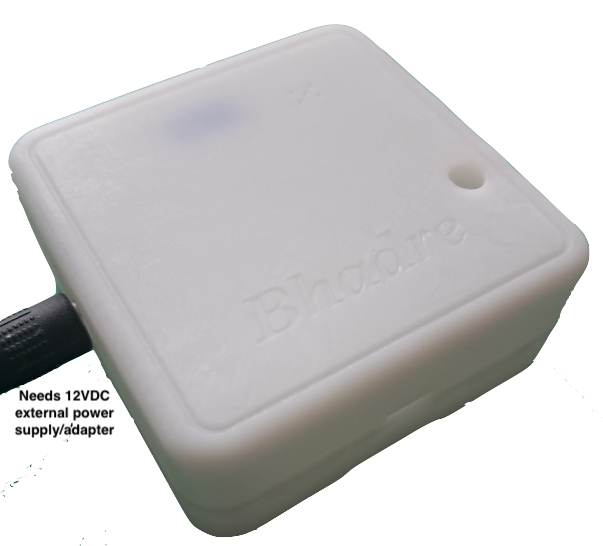
In this document, we will describe how this controller can be installed on a door, or how this can be cabled to a solenoid. This controller can be used with both Fale-Safe and Fail_secure type of electric strikes or solenoid.
2 Installing Electric Strike or Magnetic Lock
In this section, we will describe how this controller can be installed on a door with an electric strike or magnetic loack, or for controlling any solenoid. Before we get to it, have a look at the inside of the controller and its various connectors and cables. The controller can be opened by inserting a flat screw driver in the side hole of its plastic box and twisting it. Use a correct flat screw driver that has a flat end approximately as wide as the side hole on the box. Insert it slightly and twist open. You need to apply some force when twisting. You will hear a cracking sound when the latch comes out and the box opens. That sound is normal. The only time that you need to open the box is when you install it and do the cabling.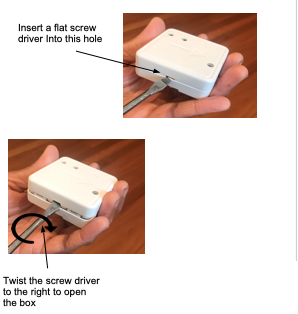
Pictures below show all the connectors and the labels on each connector. These will help when cabling and installing the controller.
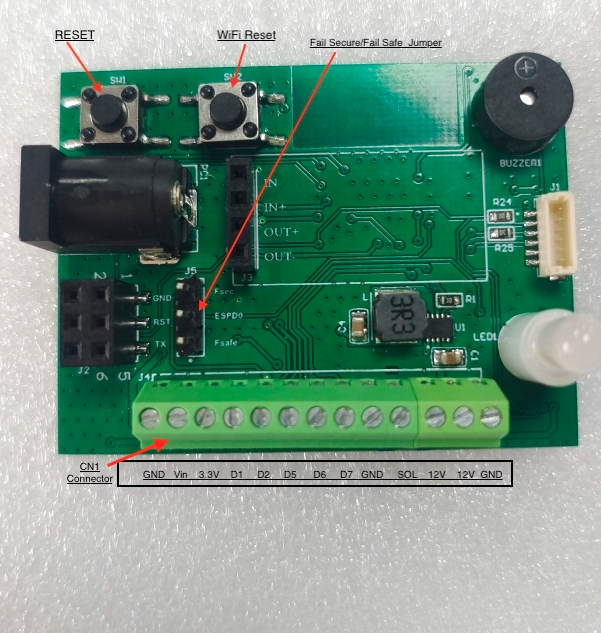
3 Proposed Installation of Bhadre controller on a door
The picture below is the proposed installation diagram of Bhadre controller on a door with electric strike of magnetic lock. The components of installation are 1) Bhadre controller, 2) Electric strike or magnetic lock, 3) Magnetic sensor (optional), and and 4) connecting cables. The magnetic sensor are optional and they may be installed only if you want its features.
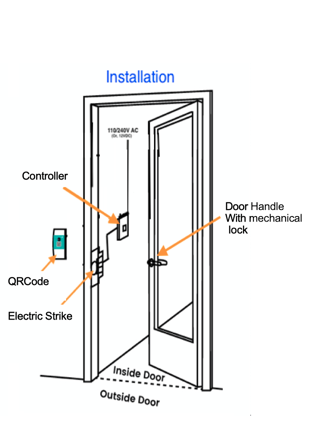
Install the parts as per the diagram above. Install scanners or QRCode tag at the outside, and controller inside the door. Use an external 12VDC power adapter (1A rating) to power the controller. Install electric strike on the door frame and cable it to the controller. Keep the current mechanical lock and key on the door. You can still use them. This will also help opening the door in the event of a power failure.
Use an electric strike that is rated 12VDC, (less than 700ma), and with sensor output. The sensor output helps to know whether or not the door is currently open or closed.
Here is a cabling diagram showing how an electric strike is cabled to the door/gate controller. Cable solenoid between 12V and SoOL pins of the green CN1 connector on the PCB board. Cable the sensor between D7 and GND of the same green CN1 connector.
Note: If you are cabling a magnetic lock or a solenoid, there will not be any sensor to be cabled. Just cable only the solenoid. If sensor is needed when installing a magnetic lock on a door, sepaerate magnetic sensor has to be purchased and installed on the door. Then it has to be cabled to GND and D7 terminals of the green CN1 connector of the controller. Installing QRCode on the outside is optional and to be installed only if you want to open the door by scanning its QRCode using a smartphone.
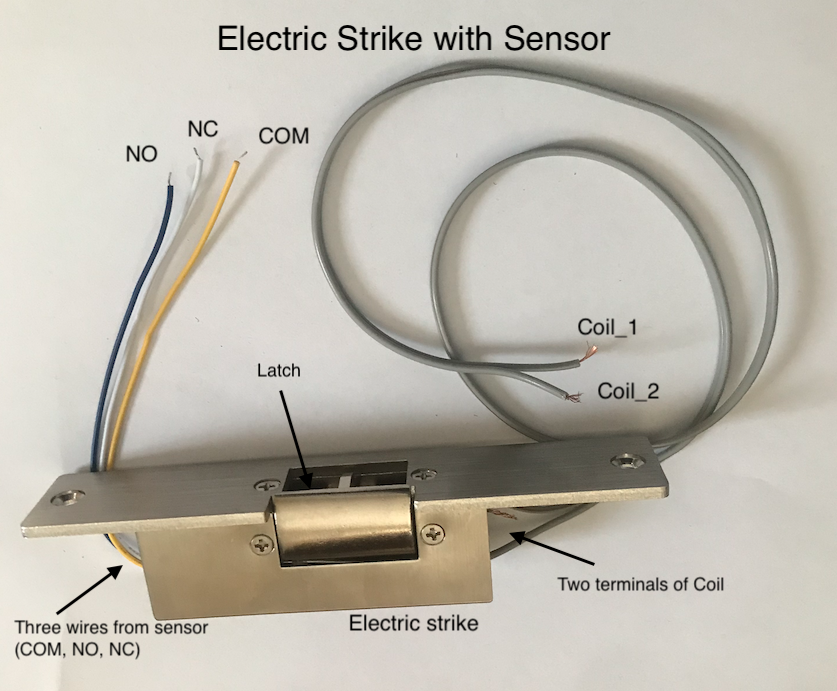
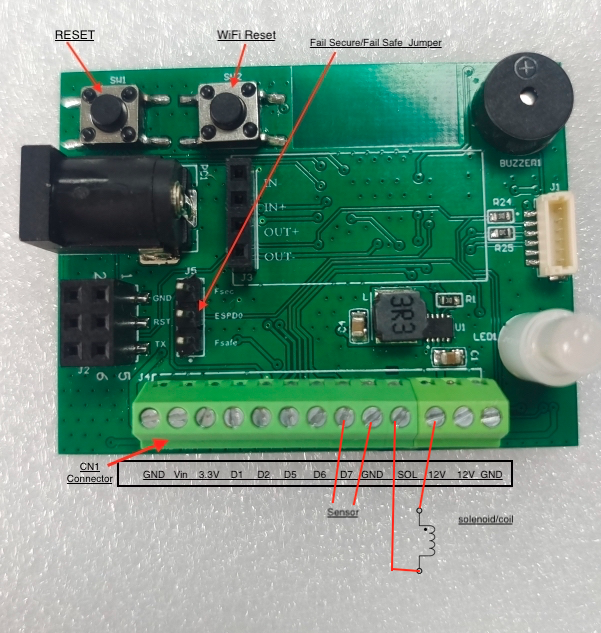
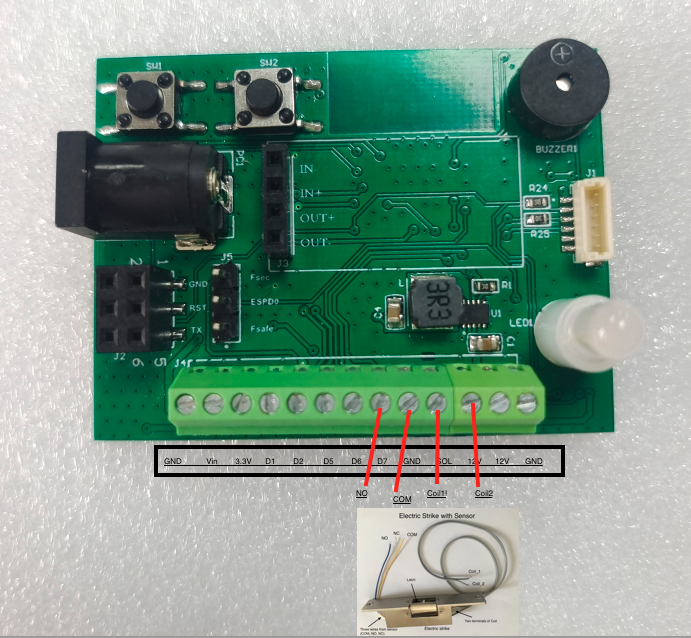
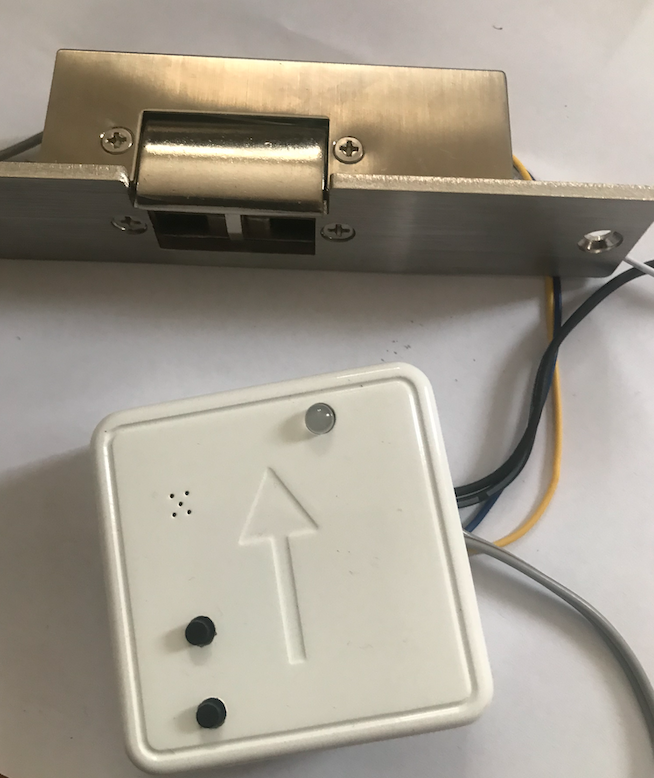
Here is a magnetic lock that can also be used with Bhadre Door controller
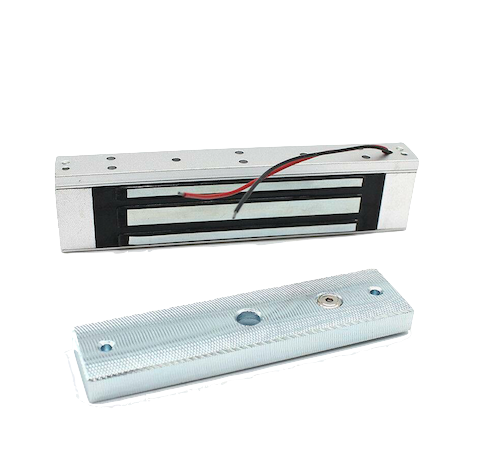
4 Installation of an electric strike on a door
To install keyless entry using Bhadre contoller, you need to install either an electric strike or a magnetic lock on the door. You have to choose the right kind of electric strike or magnetic lock that fits on your door frame. To match with the controller, the electric strike must be rated as 12VDC, and less than 700ma. It is advised to get the electric strike that has a sensor output. The sensor output will help in knowing whether the door is currently open or closed. The electric strike can be either 'Fail Secure' or 'Fail Safe' type. We recommend a 'Fail Secure' type of an electric strike. This type of strike will stay locked when the power is off and will open only when power is applied. Depending on what type of electric strike you atre using, you need to set a jumper on the PCB of the controller. This jumper is shown in Fig 22 above.

Fig 25 shows a picture of an installed door strike. You can search in YouTube for installation guides for installing an electric strike on a door frame. Alternatively, you can get this installed by a tradesperson. Once the door strike is fitted on the door, install the smart device on the wall behind the door inside the house so that it is secure. Fix it on the wall or anywhere conveniently closer to the door.
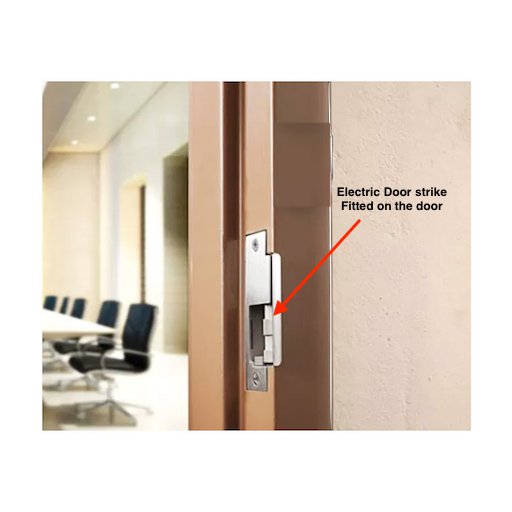
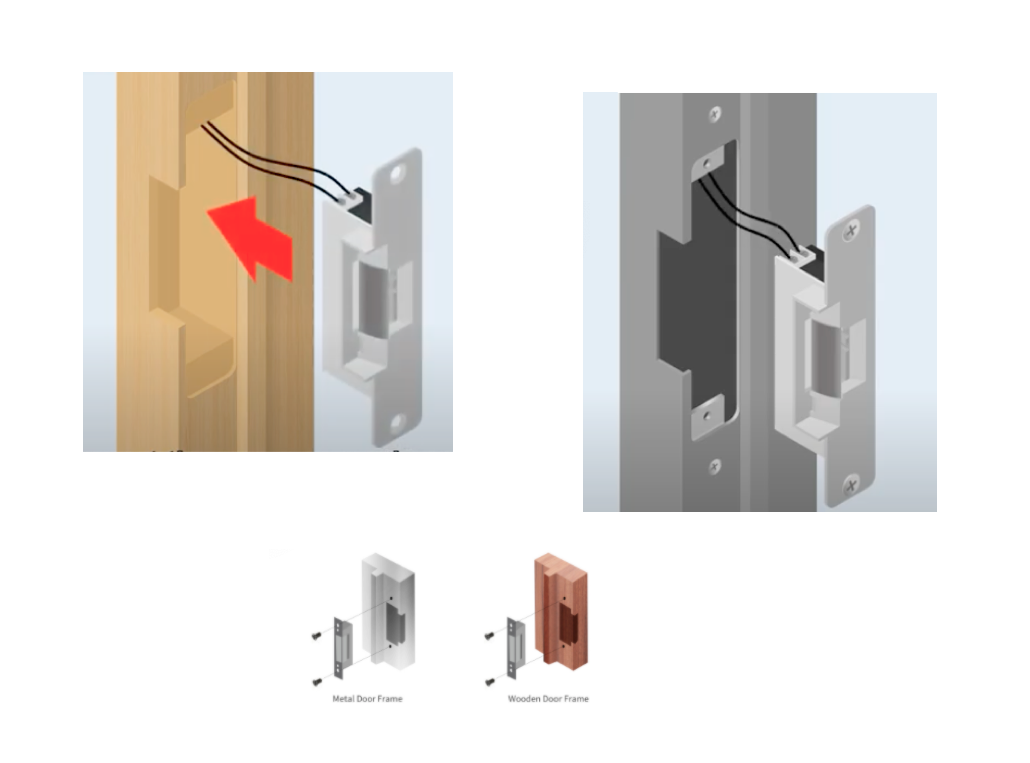
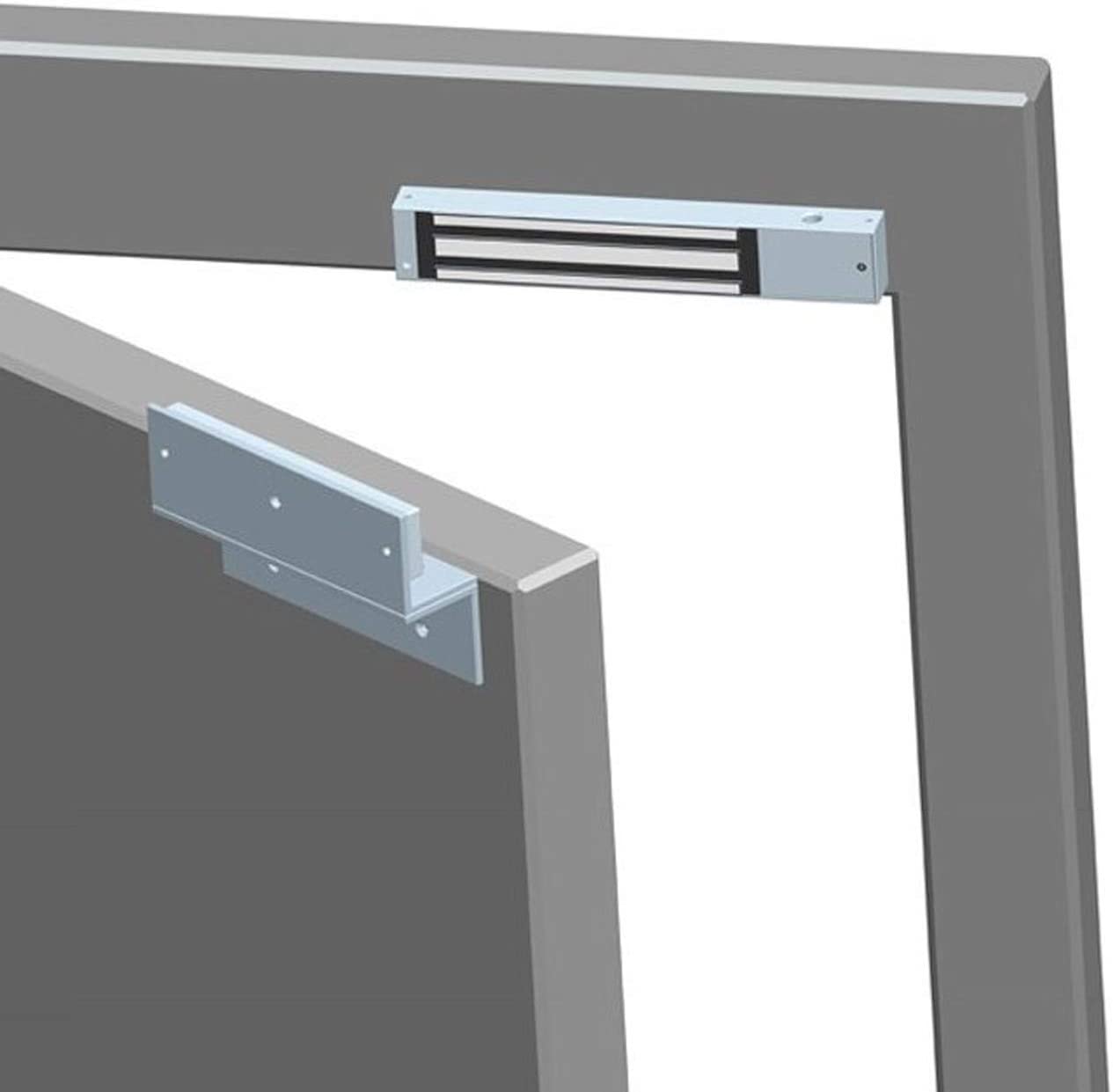
5 Attaching a manual over-riding pushbutton to activate the output port
If you want an over-riding external manual pushbutton to open or close the door, you can cable one to the controller. Cable the two terminals of the external push button to D2 and GND terminals on the green terminal connector on the PCB inside the box of the controller. Once cabled, pressing the push button will activate the door. The door will stay open as long as the push button is kept pressed. This push button can be used for opening the door to exit so that there is no security issue. Keep in mind that this push button does not check any permissions and so, anybody who has an access to it can open the door. Therefore, it can only be placed at a location inside of the door for exiting only.
6 Applying Power to the Controller
The door/solenoid controller takes 12VDC power through its power socket. So, use a 12VDC power adapter and connect it to the power connector of the controller. The power adapter must have a rating of 12VDC, and minimum 1A.Note: Power can be applied at 12V and GND terminals of the green connector inside the box, instead of applying through the 12V power socket.
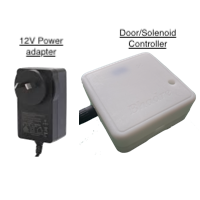
7 Initial Setup and Common Configurations
In order to use this door/solenoid controller, the controller has to be configured. This initial configuration can be done either before or after cabling it to door/solenoid.Follow the steps given in the document Initial and Common Setup and Configurations to do the initial configurations of this controller prior to using it.
8 Enabling Sensor, Enabling Notifications and Setting Duration to keep the Door/Gate open
Note: Described here in this sub section is the way to enable/disable notifications based on sensors installed on the door/gate. This is different from the type of notifications described in section 18 "Configuring Notifivcations when a device is activated" in the document "Initial and Common setup and Cofigurations"As mentioned earlier, installing and enabling sensor is optional. However, without the sensor enabled, the current position of the door/gate (open or closed) that you see in the app or a browser may not be correct. If you also operate the door/gate either manually or by any other remote control, or if someone keeps the door/gate open, Bhadre system will not know about it unless the sensor is enabled. So, in the absence of the sensor, what you see as the current position (open or closed) on the app or browser may not be correct.
Also, in order to send notifications, or to sound buzzer when the door/gate stays open for a long time, you need to install the tilt sensor or the magnetic sensor on the door/gate and cable it to the smart controller as explained earlier in this documentation. Check if the sensor is working before enabling notifications. You can see whether the sensor is currently ON or OFF by clicking 'Device Details' under Device Admin in the dashboard menu. Then click on sensor Values. Check if it reads ON when the door is closed and OFF when door is open. If it is not working, check the cabling and the gap between the two parts of the magnetic sensor (within 10mm in the closed position of the door/gate).
If you have installed sensor, check and make sure that D7_type in the device configuration is selected as "TWO STATE ON/OFF". To do that, click on "Configure Device" under Device Admin in the dashboard menu. That will open a page as shown below.
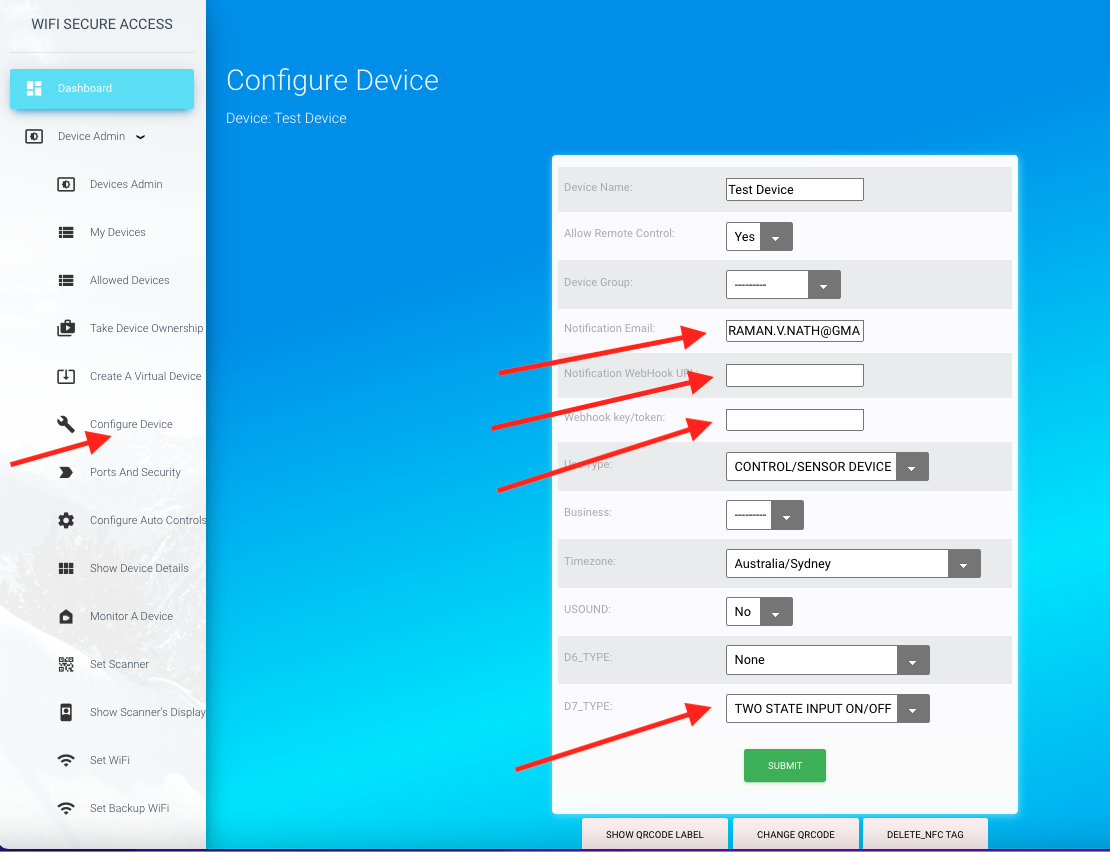
On this page, you should be seeing D7_type as TWO STATE ON/OFF. If not, select it as TWO STATE ON/OFF and press submit.
On this same configuration page, you can set the fields for sending notifications. Notification Email field shows the email address to send email notifications. By default, this is set to the email address of the owner of this device. You can change it to any other email address, if you want. If this email field is left blank, no emails will be sent.
The fields Notification Webhook URL is the URL of your webhook to which a call will be made when conditions are met to send notifications. Webhook key/token is the key or the token of your webhook. You may enter those in these two fields, if you are interested in making such calls to send notifications. If the Webhook URL is left blank, it will not make any such calls to webhook URL. The call is an HTTPS POST call with the key token in the header ('Authorization': webhook_key), and with some data in the body in JSON format. The data will have the device name, sensor_name, current value of the sensor, and a message. The following is the type of call that will be made:
HTTPS POST call
url: The Notification webhook URL
headers = {'Authorization': webhook_key, 'Content-Type': 'application/json', 'Accept': 'application/json',}
data = {"controlDevice": control_device, "sensorDevice": sensor_device, "sensor": sensor_name, "message": msg_webhook, "currentVal": current_value, "limitSet": limitVal, "msg_code": msg_code}
requests.post(notification_webhook, data=json.dumps(data), headers=headers)
Next, the notifications have to be enabled such that it sends notifications when the door stays open for a long time. It is also possible to configure it to sound an alarm (buzzer) either once or repeatedly when the door stays open.
To enable notifications, first make sure that you have installed sensor, and 'device sensor connected' field in the 'ports and Security' field is et to Yes. Then, click on Configure Auto Controls under Device Admin in the dashboard menu. That will show you a page similar to the following.
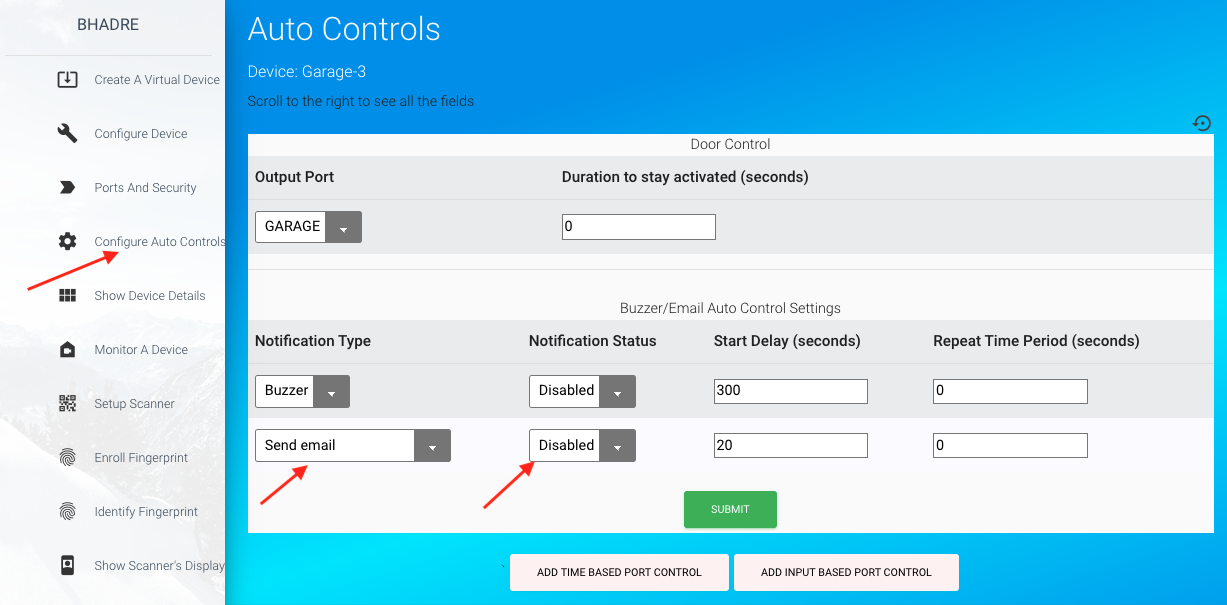
On this page, you will see three rows of controls. The first row is about auto close. A door (other than garage doors and gates) is assumed to be in AutoClose by default. In other words, they close by themselves a few seconds after opening, unless NoAutoClose is set. The field 'Duration to stay active' in the first row of controls on this page is the duration the door will stay open unless NoAutoClose is set. A value of 0 means that it is not in AutoClose mode. If it is in AutoClose mode, you can set it to anything that you like. This value is ignored in NoAutoClose. More about that can be found in the document "Configuring Auto Controls".
To send email notifications or to send a webhook call when the door/gate stays open, you need to set the next two rows on this page. The last row on this page is the setting for sending notification. To enable notification, select notification type (the first column of this control). Then click on 'Notification Status' in the last row of this page and select 'Enabled'. Then set the delay time. This is the time it will wait to send notifications or to sound buzzer since the door was opened. If you want the notifications to be sent periodically when door stays open, you can also set the 'Repeat Time Period' in seconds.
Similarly, if you want the buzzer to sound, you can select 'Notification Status' as 'Enabled' for the row corresponding to BUZZER (last but one row in Fig 126). Here also, you can set the delay time and time period of the alarm as you desire. Note that, normally the defaults will work.
To enable notifications, sensor must be cabled, and 'Door Sensor Conned' field in 'Ports and security' meny must be select to 'Yes' prior to coming to this page.
9 AutoClose and NoAutoClose Modes
There are two different modes these door controller can be configured in - AutoClose and NoAutoClose. By default, the door operates in AutoClose mode. That means that the door automatically closes after a pre-set duration of time. In AutoClose mode, the door will normally remail closed. If a sensor is cabled to the controller, one canknow the position of the door from remote. If the door remains open, the electric strike or lock will staty opeb even in AutoClose mode. The electric strike or lock can also be kept in Open position by issuing an open command when the door is open, or by a ctivating the door using the App when the door ois in open position. In autoClose mode, the lock will get closed or locked only when the door is in closed position.One can change the mode to NoAutoClose by adding the word NoAutoClose to the name of the label of the port of the controller (not in the name of the controller). To append NoAutoClose in the name of the port, click 'Ports and Security' under device admin in the Dashboard menu. That will open a page similar to the following. here, you add the word NoAutoClose in the Relay1_label.
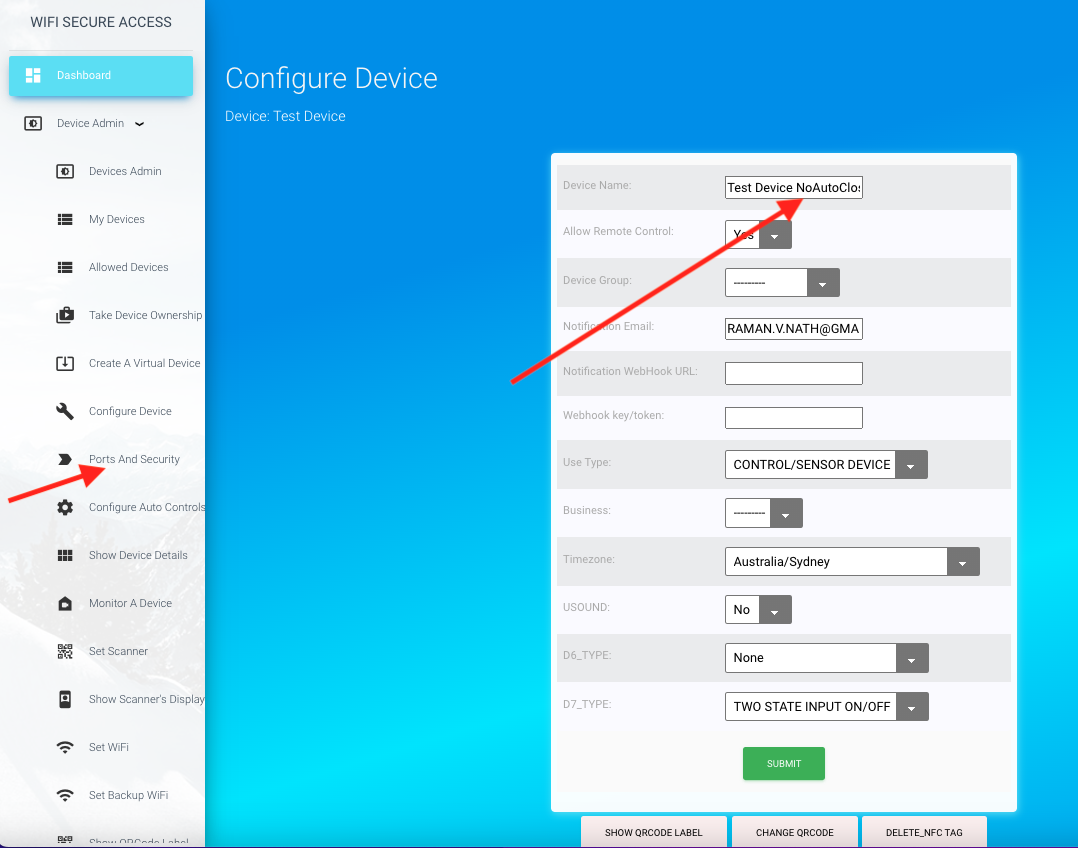
In NoAutoClose mode, it will keep the coil of the electric strike or solenoid activated until another command is given to close it. In other words, in NoAutoClose mode, and if you say, 'Hey Google, open ...', or press the button on your smartphone to open it, it will put the actuator ON and keep it ON until you give another command to close it.
10 Configuring Scheduled Actions or Additional Automatic Controls
This controller and mostly all the controllers from Bhadre have powerful features to configure automatic controls either based on sensor, or periodic, or based on sensors or other events on any other remote devices. Externa
l sensors can also be cabled to this controller as explained in the document Cabling External Sensors
Refer to Configuring Automatic Controls to configure automatic controls as well as scheduled actions. Some of the automatic controls th
at you can configure are opening or closing the door automatically regularly at some time of a day or a week
11 Allowing others to use this controller and putting restrictions on their access
If this device is controlling a gate or door of a restricted private access, the owner of this device/property has to set who can access this. The owner can allow as many people as he wants. If this is a gate/door of a public access place, anybody can open or close the gatae/door. But, the owner of the device/proiperty can set at what time people can access. In both cases, additional controls can also be configured to allow based on the profile of the person. For example, one can configure such that only females are allowed, or only people above the age of 18 are allowed, and so on. For details on how to configure these access controls, refer to the document Allowing Multiple Users12 Monitoring a Device in Real Time
Access through any door or gate can be monitored in real time by the owner of that device. When minitoring on a browser window, it will display whenever a user opens or closes that door or gate. To monitor, click on 'Monitor a Device' under "Devices Admin' in the Dashboard menu. It will prompt for the device name. Select it from the pulldown menu. Only those devices in parking_lot/Public place and those in access control mode with assigned device group will be seen in the pulldown menu. You may also have to select the display mode. There are two ways to display the details of the person who opens/or closes a door or gate. 1) scrolling and 2) profile photo. In scrolling mode, it will display the email address of the person and will scroll down when a new person opens/closes the same gate/door.and display the next person opening it. In 'Profile photo' mode, it will display the detailed identity of the person including his/her profile picture (if the person's profile picture is in the system. Once selected, it will open a browser window. The window will be empty initially with just a title displayed. If you keep this window open, you can see a new line appearing whenever a user either opens or closes that door/gate connected to that device. You will also hear a beep sound whenever that happens. This window will display the email address of the person who opens/closes the gate, if the display is in 'scrolling' mode. In a 'Profile photo' mode, it will display the identity of the perrson including his/her profile picture (if profile picture is available in his profile. If this is a parking lot, it will display the Vehicle registration number. It will also display whether this is an entry or exit. The display also has a count at the top showing the number of users in that place since you started monitoring. This number is the toal number entered minus the total number that exited. If this door/gate is an entry gate only, there will not be anyone exiting it, and vice versa. However, if this gate is for entry as well as exit, the total number displayed is the total entered - total exited. Opening a door/gate from remote will be displayed as Entry/Exit and will not be counted in the number displayed.
13 Device Use Records
The system keeps record of the use of this controller for 30 days. At any time, you can see who used this door and at what time. To see the use records, click on 'Device Use records' under 'Device admin' in the dashboard menu. You will see a page with two columns (User and use_time).You can download these use records to your computer, if you want to do so for keeping any records, or for analysing the data. To download, click on 'Download Device Use records' under Device Admin in the dashboard menu. There you can provide the dates between which you want to download the data. Leaving any of these dates will take that date as open-ended. Leaving both dates as blank wi ll download all the available use records for the past 30 days.
You can also add a program in any of your applications to download these records, and do analysis. These use records can be read using a python program. Refer to sub-section 6 of Integrating with other Apps and Programs.
14 Device Configuration Menu
Any of these configurations that you have done can be changed any time when need arises. There are many other configurations that are common to all types of devices of Bhadre. Many of them are explained in document Initial and Common Configurations. All the menu for configuring a device will be found in Devices Admin under Admin Dashboard. Have a look at the Devices Admin menus that you may need later depending the product that you purchased and depending on your application of that product.